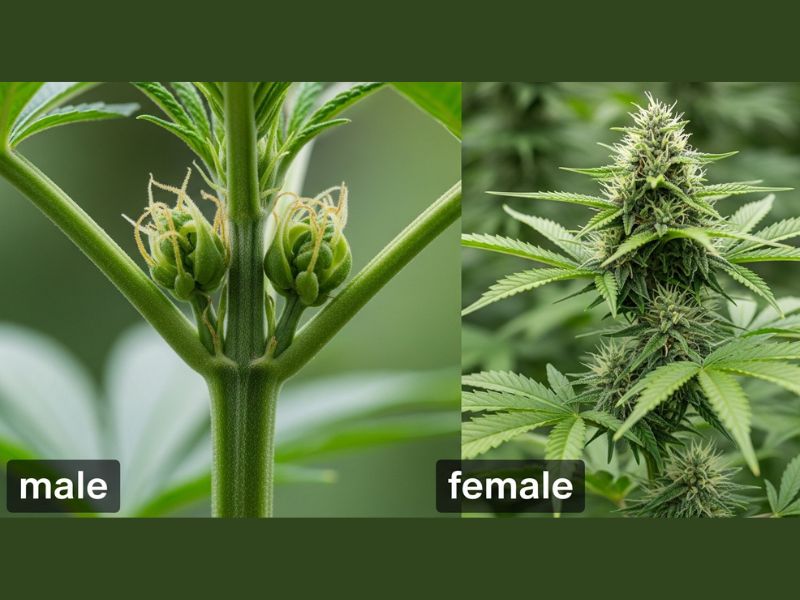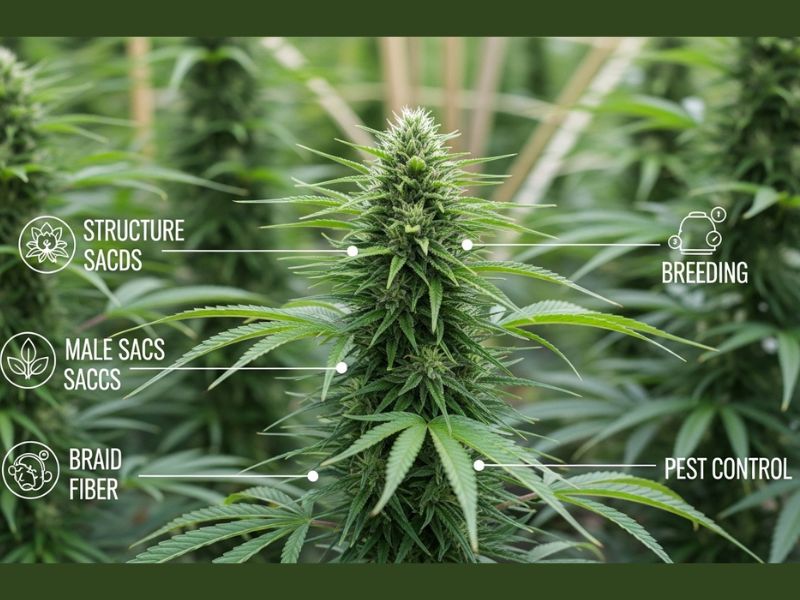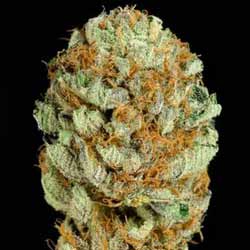6 Ways to Effectively Utilize Male Marijuana Plants
Male marijuana plants are often overlooked in cannabis cultivation due to their inability to produce buds. However, these plants offer unique benefits that can support healthy crops, improve genetics, and enhance the overall cannabis life cycle. Here’s how to effectively utilize male marijuana plants.
Table of Contents
Overview on Male Marijuana Plants
Male marijuana plants play a crucial role in the cannabis life cycle, primarily responsible for producing pollen sacs that fertilize female marijuana plants. Unlike female weed plants, which produce buds rich in THC and other cannabinoids, male weed plants focus their energy on reproduction.
While many growers remove male pot plants to prevent pollination of surrounding female plants, these males contribute to genetic diversity, seed production, and the preservation of valuable cannabis strains.
Male Vs Female Cannabis Plants
Understanding the differences between male and female cannabis plants is essential for successful cannabis cultivation. Each plays a distinct role in the growth cycle and offers unique benefits.
|
Feature |
Male Cannabis Plants | Female Cannabis Plants |
|
Purpose |
Produces pollen for seed production | Produces buds rich in THC and cannabinoids |
| Reproductive Organs | Pollen sacs (male pre flowers) | Female calyx and white hair (female pre flowers) |
|
Bud Production |
Do not produce usable buds |
Produce buds during flowering stage |
|
Plant Structure |
Taller with thicker stalks and fewer leaves |
Shorter, bushier with more foliage |
|
Growth Stage Appearance |
Show sex earlier in the vegetative stage |
Develop pre flowers slightly later |
|
THC Content |
Very low |
High |
|
Cultivation Use |
Used for breeding and genetic diversity |
Used for harvesting flower buds and cannabinoids |
|
Risk Factor |
Can pollinate and reduce yield of female plants |
Must be isolated to prevent accidental pollination |
| Industrial Use | Valued for hemp fiber and certain traits |
Valued for producing potent cannabis strains |
How to Identify a Male Cannabis Plant

Identifying a male cannabis plant early in the growth cycle is crucial to prevent unwanted pollination of female counterparts. Here are key traits to look for:
- Pollen sacs: Small, round balls that appear at the nodes where branches meet the main stem.
- Early development: Male pre-flowers typically appear one to three weeks earlier than female organs.
- Thicker stalks: Built to support taller growth and the weight of pollen sacs.
- Fewer leaves: Male weed plants tend to be less bushy with more spaced-out foliage.
- No white hairs: Lacks the pistils (white hair) that signify female pre-flowers.
How to Use Male Marijuana Plants
While most growers prioritize only female cannabis plants for their potent buds, male marijuana plants have several valuable uses that can benefit cannabis cultivation and the broader cannabis industry.
1. Breeding and Genetic Improvement
Male cannabis plants are essential for creating new cannabis strains and preserving genetic diversity. By carefully selecting male counterparts with desirable traits—such as pest resistance, growth patterns, or stronger stems—growers can enhance future generations. Controlled pollination ensures the traits are passed on to female plants, maintaining or improving the gene pool.
2. Seed Production
To produce seeds, male and female plants must interact naturally or through guided pollination. Most growers interested in creating stable seeds or developing hybrid strains utilize male marijuana for this purpose. This is a foundational step in cannabis cultivation for both commercial seed banks and personal growers.
3. Hemp Fiber Harvesting
Male pot plants, especially those cultivated for industrial hemp, produce softer fibers than females, making them ideal for textiles, paper, and rope. Their tall growth and fewer branches make harvesting cleaner and more efficient for this purpose.
4. Repelling Pests
Some growers leave a few male plants in the garden to help repel pests from other crops. The presence of male cannabis plants can serve as a natural deterrent to certain insects, contributing to organic pest control strategies.
5. Soil and Growth Experimentation
Since male marijuana plants aren’t typically grown for flower buds, they are useful for testing soil quality, nutrients, grow lights, and watering schedules. Their response to these variables offers insights that can then be applied to optimize the care of female cannabis.
6. Educational and Training Purposes
Male weed plants provide a low-risk opportunity for new growers to learn about plant care, the cannabis life cycle, and how to distinguish plant’s sex. Understanding how male pre-flowers develop can also help prevent pollination when cultivating only female plants for THC content.
Tips to Effectively Use Male Cannabis Plants
To make the most of male cannabis plants, growers need to manage them with intention and care. Here are some effective tips:
- Identify Early in the Vegetative Stage: Detect male pre-flowers within one to three weeks of development to separate male and female plants early and avoid accidental pollination.
- Isolate Immediately: Once identified, relocate male marijuana plants to a separate grow space to prevent pollen sacs from fertilizing surrounding female plants.
- Select for Desired Traits: Choose males with strong main stems, pest resistance, and other favorable growth patterns to pass on certain traits during breeding.
- Harvest Pollen Carefully: When collecting pollen, ensure complete darkness and low humidity to maintain viability, and store it in an airtight container to use for controlled seed production.
- Pair With Female Counterparts Strategically: Use only female cannabis plants with proven genetics to match selected males for consistent and valuable cannabis strains.
- Monitor for Hermaphrodites: Sometimes stress causes hermaphrodite cannabis plants to develop; keep a close eye to remove these to maintain gene purity.
- Reuse for Training or Testing: Utilize male pot plants for pruning practice, nutrient testing, or experimenting with pest control without risking the quality of usable buds from females.
Final Thoughts

Male marijuana plants may not produce buds, but their role in cannabis cultivation is far from insignificant. From enhancing genetic diversity to supporting pest control and hemp fiber production, male cannabis plants offer numerous benefits when used thoughtfully. By understanding their traits and managing them properly, growers can unlock their full potential and contribute to a stronger, more sustainable cannabis gene pool. For growers looking to optimize every stage of the cultivation process, studying the value of male cannabis plants is a smart next step. Find out more insights and techniques by looking into related cannabis cultivation topics.
Frequently Asked Questions
What happens if you leave male cannabis plants with females during flowering?
If male cannabis plants are left with female marijuana plants during the flowering stage, they will release pollen from their sacs and fertilize the females. This results in the production of seeds rather than potent, seedless buds (sinsemilla), significantly reducing the THC content and overall quality of the harvest. To prevent pollination, it’s essential to separate male and female plants early in the cannabis life cycle.
Can male cannabis plants produce THC or other cannabinoids?
Male cannabis plants do produce trace amounts of THC and other cannabinoids, but at significantly lower levels than female cannabis. These compounds are usually found in small amounts on the leaves and stems, but not in concentrations high enough for recreational or medical use. As such, male weed plants are not typically used for extracting cannabinoids.
Are male marijuana plants legal to grow?
The legality of growing male marijuana plants depends on your local cannabis laws. In regions where cannabis cultivation is legal—either for recreational or medical marijuana use—growing male plants is usually allowed. However, some regulations may specify plant limits or require that only flowering (female) plants be counted, so it’s best to consult local laws before cultivating.
How do you collect and store pollen from male cannabis plants?
To collect pollen, wait until the pollen sacs are fully developed but not yet open. Gently tap the sacs over a clean surface or container to release the pollen. Store the collected pollen in an airtight container in the freezer with a desiccant to prevent moisture buildup. This helps preserve its viability for future use in breeding or seed production.
Can male cannabis plants self-pollinate?
Male cannabis plants cannot self-pollinate in the same way hermaphrodite cannabis plants can. They lack female organs necessary for fertilization. However, if a plant becomes a true hermaphrodite—exhibiting both male and female traits—it can potentially self-pollinate. These cases are uncommon but possible, usually triggered by stress or genetics.
Related Posts
Cloning Cannabis: 5 Great Benefits and Step-By-Step Guide
6 Ways to Effectively Utilize Male Marijuana Plants
Cannabis Trimming: 5 Benefits and How to Do It Properly
CATEGORIES
Best Selling Seeds











